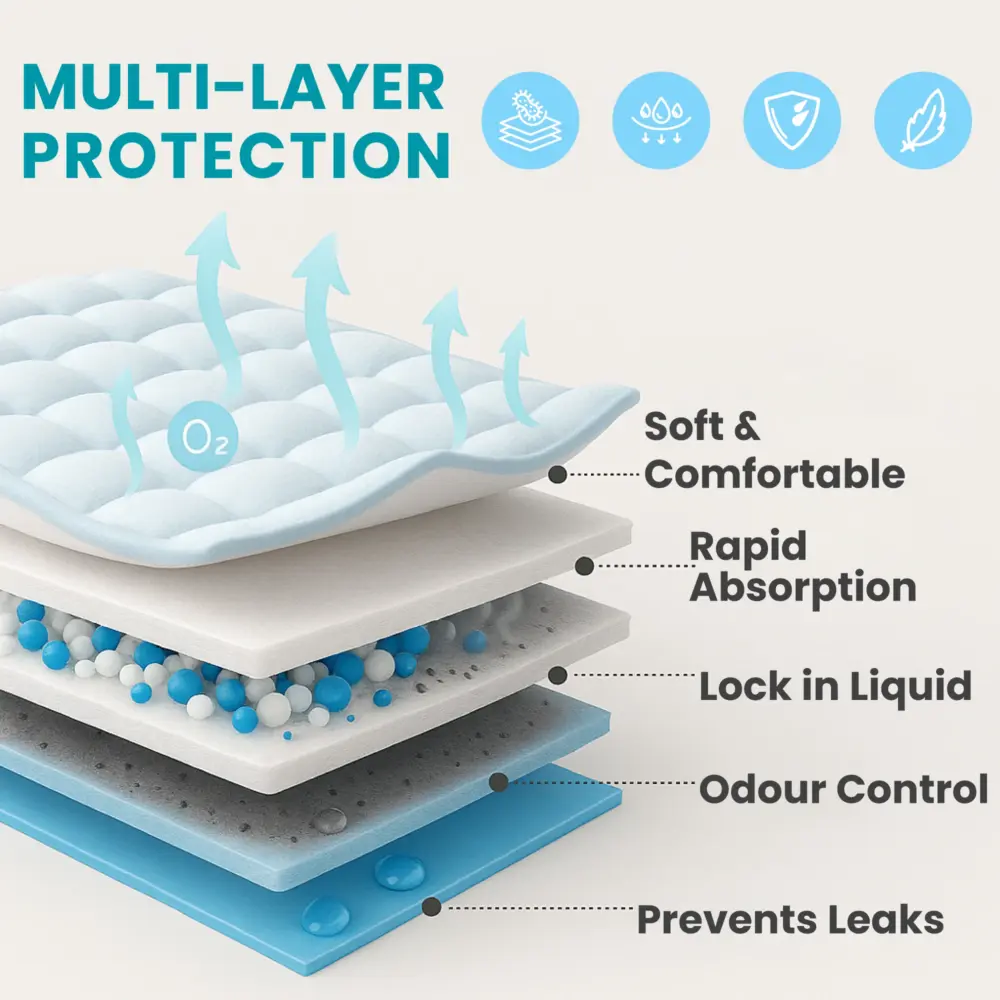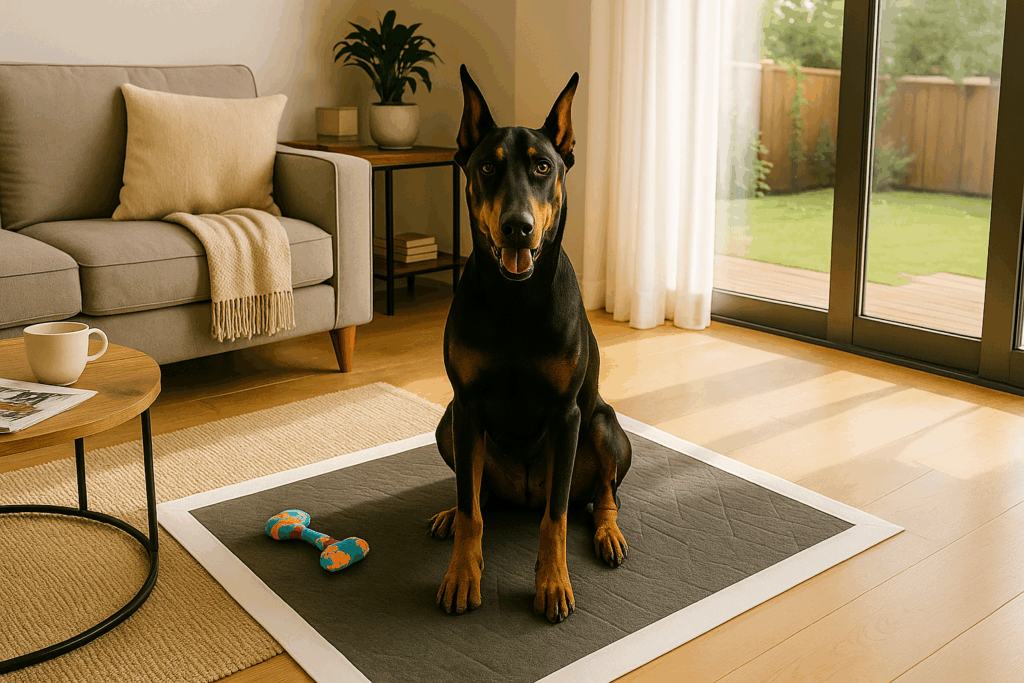The Complete Guide to Pee Pad Training: Transform Your Dog’s Indoor Bathroom Habits
House training doesn’t always mean heading outdoors. Whether you’re dealing with a tiny puppy, a senior dog with mobility issues, or living in a high-rise apartment, pee pads can be a game-changer for you and your furry friend. Let’s dive into everything you need to know about successful pee pad training.
Understanding Pee Pads: More Than Just Absorbent Paper
Dog pee pads have evolved significantly from simple newspaper layouts. Today’s modern training pads feature sophisticated multi-layer construction designed to handle your dog’s bathroom needs while protecting your floors and minimizing odors.

Who Benefits Most from Pee Pad Training?
- Puppies under 16 weeks who can’t hold their bladder for long periods
- Senior dogs experiencing incontinence or mobility challenges
- Dogs recovering from surgery or illness
- Urban pet owners with limited outdoor access
- Working professionals who can’t always provide immediate outdoor breaks
Choosing the Right Size: One Size Doesn’t Fit All
The effectiveness of pee pad training often comes down to selecting the appropriate size for your dog. Here’s what works best:
- Small Dogs Pee Pads (Under 25 lbs): Standard 18″ x 24″ pads provide adequate space without overwhelming smaller breeds.
- Medium Dogs Pee Pads (25-60 lbs): Opt for 24″ x 36″ pads to ensure your dog has enough room to position themselves comfortably.
- Large Dogs Pee Pads (60+ lbs): Extra-large 36″ x 48″ pads prevent accidents around the edges and accommodate larger breeds’ spatial needs.
- XXL Dog Pee Pads: Consider oversized 36″ x 36″ pads or multiple standard-sized pads strategically placed throughout your home.
The Science Behind Successful Pee Pad Training
Training your dog to use pee pads isn’t just about convenience—it’s about understanding canine behavior and working with your dog’s natural instincts.
Setting the Foundation
Location is Everything Choose a quiet, easily accessible area away from your dogs food and sleeping areas. Dogs naturally avoid soiling spaces where they eat or rest, so respect this instinct. A bathroom corner, laundry room, or designated hallway spot often works well.
Consistency Breeds Success Once you’ve chosen a location, stick with it. Moving the pad around confuses your dog and slows the training process. If you need to relocate later, do so gradually—moving the pad just a few inches each day.
The 7-Day Training Protocol
- Days 1-2: Introduction Phase Begin by placing multiple pads in your chosen area. Allow your dog to investigate and sniff the pads without pressure. Some dogs need time to understand this new bathroom option.
- Days 3-4: Guided Practice Watch for pre-bathroom behaviors: sniffing, circling, whining, or heading toward the door. When you notice these signs, calmly lead your dog to the pad area using a leash if necessary. Use a consistent verbal cue like “go potty” or “use your pad.”
- Days 5-6: Reinforcement The moment your dog successfully uses the pad, immediately praise them enthusiastically and offer a high-value treat. This positive association is crucial for long-term success.
- Day 7 and Beyond: Maintenance Continue supervising and reinforcing good habits. Gradually reduce the number of pads if you started with multiple, leaving just one in the designated area.
Read more: How to Teach a Dog to Use a Pee Pad (The Complete Pet Parent Guide)
Common Training Challenges and Solutions
- Challenge: Your dog keeps missing the pad Solution: You may need a larger pad size, or your dog might need more guidance to the exact spot. Consider using attractant sprays designed for training pads.
- Challenge: Accidents happen right next to the pad Solution: This often indicates your dog understands the general area but needs more precise positioning. Gently place them on the pad when you see pre-bathroom behaviors.
- Challenge: Your dog treats the pad like a toy Solution: Redirect this behavior immediately with a firm “no” and offer an appropriate toy. Some dogs are attracted to the texture or crinkle sound of pads.
- Challenge: Successful pad use during the day, accidents at night Solution: Consider placing an additional pad in your bedroom or confining your dog to the pad area overnight with baby gates.

Advanced Tips for Faster Results
- Create a Bathroom Schedule Take your dog to the pad at predictable times: immediately after waking up, 15-30 minutes after meals, after play sessions, and right before bedtime. Puppies may need hourly visits initially.
- Use Positive Interruption If you catch your dog starting to have an accident elsewhere, don’t scold them. Instead, calmly but quickly say “oops” and guide them to the pad to finish.
- Clean Accidents Thoroughly Use enzymatic cleaners specifically designed for pet accidents. Regular household cleaners won’t eliminate the scent that draws dogs back to the same spot.
- Maintain Pad Freshness Replace soiled pads promptly. A dirty pad becomes less attractive to your dog and may lead them to find alternative bathroom spots.
Transitioning from Pads to Outdoor Potty Breaks
If your goal is eventual outdoor house training, pee pads can serve as a stepping stone rather than a permanent solution.
The Gradual Move Method Start moving the pad closer to your exit door by a few inches each day. Eventually, place it right by the door, then just outside the door, and finally eliminate it altogether as your dog learns to signal for outdoor bathroom breaks.
Timing the Transition Wait until your dog consistently uses the indoor pad before beginning outdoor training. Rushing this process often leads to confusion and setbacks.
Selecting Quality Training Pads
Not all pee pads are created equal. Look for these essential features:
- Superior Absorption: Multi-layer construction with a polymer core that can handle multiple uses if necessary.
- Leak-Proof Backing: Waterproof material that protects your floors from moisture damage.
- Odor Control: Built-in odor neutralizers or antimicrobial treatments that keep your home fresh.
- Quick-Dry Surface: A top layer that wicks moisture away, preventing tracking and keeping your dog’s paws dry.
- Proper Size Options: Variety of sizes to match your dog’s breed and space requirements.
The Reality Check: What to Expect
Pee pad training isn’t an overnight miracle. Most dogs need 2-4 weeks to fully grasp the concept, and some may take longer. Puppies under 12 weeks may need several months to develop reliable bathroom habits.
Success Factors:
- Your consistency with training methods
- Your dog’s age and learning capacity
- Environmental distractions in your home
- Previous house training experiences
Remember, every accident is a learning opportunity, not a failure. Stay patient, maintain consistency, and celebrate small victories along the way.
Making Pee Pad Training Work for Your Lifestyle
- For Busy Professionals: Set up multiple pad stations if you’re away for extended periods. Consider using cameras to monitor your dog’s bathroom habits and adjust your training accordingly.
- For Apartment Dwellers: Pee pads can provide peace of mind during elevator outages, extreme weather, or when your dog’s walk schedule doesn’t align with their biological needs.
- For Senior Pet Parents: Pads offer dignity for older dogs who may struggle with bladder control, allowing them to maintain bathroom independence.
Read more: Where Should My Dog Pee in an Apartment? A Complete Guide to Indoor Potty Solutions
Troubleshooting: When Things Go Wrong
If your dog consistently refuses to use pads after several weeks of training, consider these factors:
- Medical issues affecting bladder control
- Stress or anxiety about the designated bathroom area
- Previous negative associations with similar materials
- Inadequate supervision during the learning phase
Don’t hesitate to consult with your veterinarian or a professional dog trainer if you’re facing persistent challenges.
Conclusion
Pee pad training offers flexibility and convenience for many dog owners, but it requires patience, consistency, and the right approach for your individual dog. By understanding your dog’s needs, maintaining a regular routine, and choosing quality training materials, you can successfully teach your furry friend this valuable skill.
Remember, every dog is unique. What works perfectly for your neighbor’s Chihuahua might need adjustment for your Golden Retriever. Stay flexible in your approach while maintaining consistency in your expectations, and you’ll be well on your way to pee pad training success.
Frequently Asked Questions (FAQs)
How long does it take to potty train a dog with pee pads?
Most dogs learn within 2 to 4 weeks, depending on age, consistency, and breed. Puppies and senior dogs may take a little longer.
Should I leave pee pads out all the time?
Yes, especially in the early stages. Consistent access helps your dog understand where they’re supposed to go. Over time, you can limit pad access to encourage outdoor training.
How do I stop my dog from chewing or shredding the pee pad?
Choose tear-resistant pads or pads with adhesive backing. If your dog chews, redirect them with a toy and supervise closely until the habit stops.
Can I transition my dog from pee pads to going outside?
Absolutely! Start by moving the pad closer to the door, then outside. Praise and reward your dog each time they use the outdoor spot until they no longer need the pad.
How often should I change the pee pad?
Replace the pad as soon as it’s soiled. For hygiene and odor control, change at least once daily, even if it isn’t fully used.
Discover more from Bulk Price
Subscribe to get the latest posts sent to your email.


